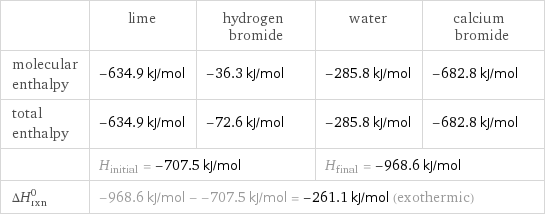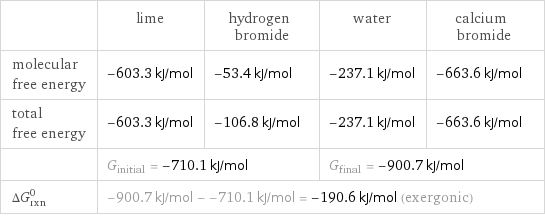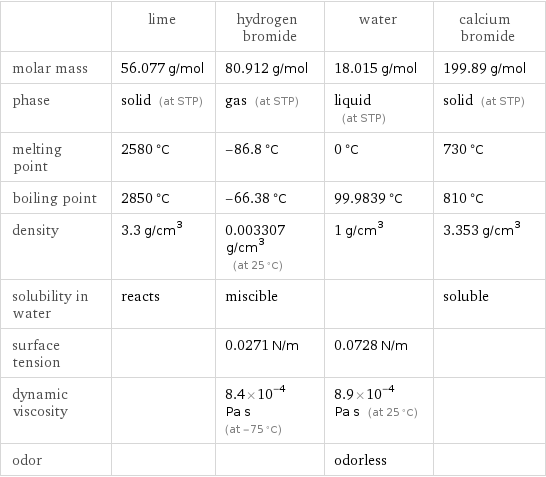Input interpretation

CaO lime + HBr hydrogen bromide ⟶ H_2O water + CaBr_2 calcium bromide
Balanced equation

Balance the chemical equation algebraically: CaO + HBr ⟶ H_2O + CaBr_2 Add stoichiometric coefficients, c_i, to the reactants and products: c_1 CaO + c_2 HBr ⟶ c_3 H_2O + c_4 CaBr_2 Set the number of atoms in the reactants equal to the number of atoms in the products for Ca, O, Br and H: Ca: | c_1 = c_4 O: | c_1 = c_3 Br: | c_2 = 2 c_4 H: | c_2 = 2 c_3 Since the coefficients are relative quantities and underdetermined, choose a coefficient to set arbitrarily. To keep the coefficients small, the arbitrary value is ordinarily one. For instance, set c_1 = 1 and solve the system of equations for the remaining coefficients: c_1 = 1 c_2 = 2 c_3 = 1 c_4 = 1 Substitute the coefficients into the chemical reaction to obtain the balanced equation: Answer: | | CaO + 2 HBr ⟶ H_2O + CaBr_2
Structures

+ ⟶ +
Names

lime + hydrogen bromide ⟶ water + calcium bromide
Reaction thermodynamics
Enthalpy

| lime | hydrogen bromide | water | calcium bromide molecular enthalpy | -634.9 kJ/mol | -36.3 kJ/mol | -285.8 kJ/mol | -682.8 kJ/mol total enthalpy | -634.9 kJ/mol | -72.6 kJ/mol | -285.8 kJ/mol | -682.8 kJ/mol | H_initial = -707.5 kJ/mol | | H_final = -968.6 kJ/mol | ΔH_rxn^0 | -968.6 kJ/mol - -707.5 kJ/mol = -261.1 kJ/mol (exothermic) | | |
Gibbs free energy

| lime | hydrogen bromide | water | calcium bromide molecular free energy | -603.3 kJ/mol | -53.4 kJ/mol | -237.1 kJ/mol | -663.6 kJ/mol total free energy | -603.3 kJ/mol | -106.8 kJ/mol | -237.1 kJ/mol | -663.6 kJ/mol | G_initial = -710.1 kJ/mol | | G_final = -900.7 kJ/mol | ΔG_rxn^0 | -900.7 kJ/mol - -710.1 kJ/mol = -190.6 kJ/mol (exergonic) | | |
Equilibrium constant
![Construct the equilibrium constant, K, expression for: CaO + HBr ⟶ H_2O + CaBr_2 Plan: • Balance the chemical equation. • Determine the stoichiometric numbers. • Assemble the activity expression for each chemical species. • Use the activity expressions to build the equilibrium constant expression. Write the balanced chemical equation: CaO + 2 HBr ⟶ H_2O + CaBr_2 Assign stoichiometric numbers, ν_i, using the stoichiometric coefficients, c_i, from the balanced chemical equation in the following manner: ν_i = -c_i for reactants and ν_i = c_i for products: chemical species | c_i | ν_i CaO | 1 | -1 HBr | 2 | -2 H_2O | 1 | 1 CaBr_2 | 1 | 1 Assemble the activity expressions accounting for the state of matter and ν_i: chemical species | c_i | ν_i | activity expression CaO | 1 | -1 | ([CaO])^(-1) HBr | 2 | -2 | ([HBr])^(-2) H_2O | 1 | 1 | [H2O] CaBr_2 | 1 | 1 | [CaBr2] The equilibrium constant symbol in the concentration basis is: K_c Mulitply the activity expressions to arrive at the K_c expression: Answer: | | K_c = ([CaO])^(-1) ([HBr])^(-2) [H2O] [CaBr2] = ([H2O] [CaBr2])/([CaO] ([HBr])^2)](../image_source/4799e156f48f4d417164b3830618e8af.png)
Construct the equilibrium constant, K, expression for: CaO + HBr ⟶ H_2O + CaBr_2 Plan: • Balance the chemical equation. • Determine the stoichiometric numbers. • Assemble the activity expression for each chemical species. • Use the activity expressions to build the equilibrium constant expression. Write the balanced chemical equation: CaO + 2 HBr ⟶ H_2O + CaBr_2 Assign stoichiometric numbers, ν_i, using the stoichiometric coefficients, c_i, from the balanced chemical equation in the following manner: ν_i = -c_i for reactants and ν_i = c_i for products: chemical species | c_i | ν_i CaO | 1 | -1 HBr | 2 | -2 H_2O | 1 | 1 CaBr_2 | 1 | 1 Assemble the activity expressions accounting for the state of matter and ν_i: chemical species | c_i | ν_i | activity expression CaO | 1 | -1 | ([CaO])^(-1) HBr | 2 | -2 | ([HBr])^(-2) H_2O | 1 | 1 | [H2O] CaBr_2 | 1 | 1 | [CaBr2] The equilibrium constant symbol in the concentration basis is: K_c Mulitply the activity expressions to arrive at the K_c expression: Answer: | | K_c = ([CaO])^(-1) ([HBr])^(-2) [H2O] [CaBr2] = ([H2O] [CaBr2])/([CaO] ([HBr])^2)
Rate of reaction
![Construct the rate of reaction expression for: CaO + HBr ⟶ H_2O + CaBr_2 Plan: • Balance the chemical equation. • Determine the stoichiometric numbers. • Assemble the rate term for each chemical species. • Write the rate of reaction expression. Write the balanced chemical equation: CaO + 2 HBr ⟶ H_2O + CaBr_2 Assign stoichiometric numbers, ν_i, using the stoichiometric coefficients, c_i, from the balanced chemical equation in the following manner: ν_i = -c_i for reactants and ν_i = c_i for products: chemical species | c_i | ν_i CaO | 1 | -1 HBr | 2 | -2 H_2O | 1 | 1 CaBr_2 | 1 | 1 The rate term for each chemical species, B_i, is 1/ν_i(Δ[B_i])/(Δt) where [B_i] is the amount concentration and t is time: chemical species | c_i | ν_i | rate term CaO | 1 | -1 | -(Δ[CaO])/(Δt) HBr | 2 | -2 | -1/2 (Δ[HBr])/(Δt) H_2O | 1 | 1 | (Δ[H2O])/(Δt) CaBr_2 | 1 | 1 | (Δ[CaBr2])/(Δt) (for infinitesimal rate of change, replace Δ with d) Set the rate terms equal to each other to arrive at the rate expression: Answer: | | rate = -(Δ[CaO])/(Δt) = -1/2 (Δ[HBr])/(Δt) = (Δ[H2O])/(Δt) = (Δ[CaBr2])/(Δt) (assuming constant volume and no accumulation of intermediates or side products)](../image_source/1f2132e83ba7d945602577f7036a10a1.png)
Construct the rate of reaction expression for: CaO + HBr ⟶ H_2O + CaBr_2 Plan: • Balance the chemical equation. • Determine the stoichiometric numbers. • Assemble the rate term for each chemical species. • Write the rate of reaction expression. Write the balanced chemical equation: CaO + 2 HBr ⟶ H_2O + CaBr_2 Assign stoichiometric numbers, ν_i, using the stoichiometric coefficients, c_i, from the balanced chemical equation in the following manner: ν_i = -c_i for reactants and ν_i = c_i for products: chemical species | c_i | ν_i CaO | 1 | -1 HBr | 2 | -2 H_2O | 1 | 1 CaBr_2 | 1 | 1 The rate term for each chemical species, B_i, is 1/ν_i(Δ[B_i])/(Δt) where [B_i] is the amount concentration and t is time: chemical species | c_i | ν_i | rate term CaO | 1 | -1 | -(Δ[CaO])/(Δt) HBr | 2 | -2 | -1/2 (Δ[HBr])/(Δt) H_2O | 1 | 1 | (Δ[H2O])/(Δt) CaBr_2 | 1 | 1 | (Δ[CaBr2])/(Δt) (for infinitesimal rate of change, replace Δ with d) Set the rate terms equal to each other to arrive at the rate expression: Answer: | | rate = -(Δ[CaO])/(Δt) = -1/2 (Δ[HBr])/(Δt) = (Δ[H2O])/(Δt) = (Δ[CaBr2])/(Δt) (assuming constant volume and no accumulation of intermediates or side products)
Chemical names and formulas

| lime | hydrogen bromide | water | calcium bromide formula | CaO | HBr | H_2O | CaBr_2 Hill formula | CaO | BrH | H_2O | Br_2Ca name | lime | hydrogen bromide | water | calcium bromide IUPAC name | | hydrogen bromide | water | calcium dibromide
Substance properties

| lime | hydrogen bromide | water | calcium bromide molar mass | 56.077 g/mol | 80.912 g/mol | 18.015 g/mol | 199.89 g/mol phase | solid (at STP) | gas (at STP) | liquid (at STP) | solid (at STP) melting point | 2580 °C | -86.8 °C | 0 °C | 730 °C boiling point | 2850 °C | -66.38 °C | 99.9839 °C | 810 °C density | 3.3 g/cm^3 | 0.003307 g/cm^3 (at 25 °C) | 1 g/cm^3 | 3.353 g/cm^3 solubility in water | reacts | miscible | | soluble surface tension | | 0.0271 N/m | 0.0728 N/m | dynamic viscosity | | 8.4×10^-4 Pa s (at -75 °C) | 8.9×10^-4 Pa s (at 25 °C) | odor | | | odorless |
Units
